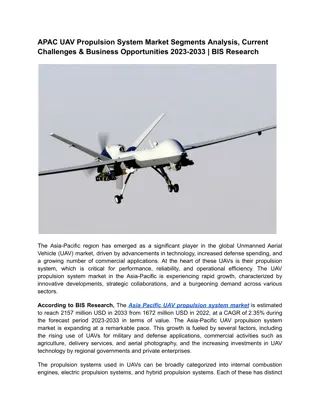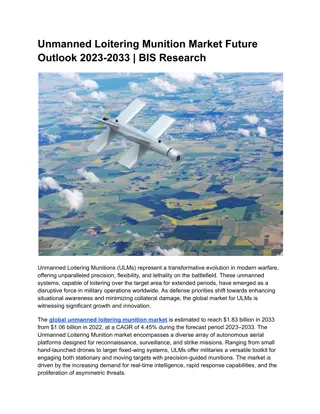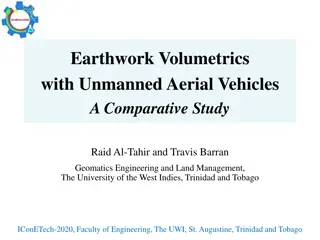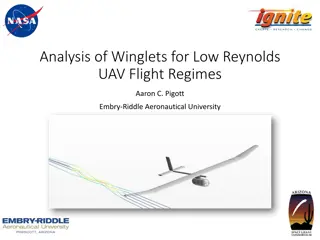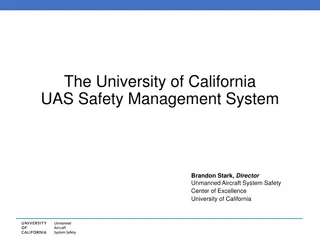
Unmanned Aerial System Market Analysis by 2033
The global unmanned aerial system (UAS) market is estimated to reach $72.42 billion by 2033 from $18.10 billion in 2023, growing at a CAGR of 14.87% during the forecast period 2023-2033.nnRead Report Overview: //bisresearch.com/industry-report/
Download Presentation

Please find below an Image/Link to download the presentation.
The content on the website is provided AS IS for your information and personal use only. It may not be sold, licensed, or shared on other websites without obtaining consent from the author. If you encounter any issues during the download, it is possible that the publisher has removed the file from their server.
You are allowed to download the files provided on this website for personal or commercial use, subject to the condition that they are used lawfully. All files are the property of their respective owners.
The content on the website is provided AS IS for your information and personal use only. It may not be sold, licensed, or shared on other websites without obtaining consent from the author.
E N D
Presentation Transcript
Unmanned Aerial System (UAS) Market: Growth, Trends, and Future Opportunities The Unmanned Aerial System (UAS) market, commonly known as the drone industry, is experiencing unprecedented growth. With advancements in technology, UAS has become a critical component in various sectors, including defense, agriculture, logistics, and infrastructure. According to BIS Research, the global and Asia-Pacific unmanned aerial system (UAS) market is estimated to reach $72.42 billion by 2033 from $18.10 billion in 2023, growing at a CAGR of 14.87% during the forecast
period 2023-2033. This significant growth is driven by increasing investments in drone technology, the rising demand for aerial data services, and the expanding applications of drones across various industries. Overview of the Unmanned Aerial System Market The UAS market encompasses a wide range of drone technologies, including fixed-wing, rotary-wing, and hybrid systems. These unmanned systems are controlled remotely or autonomously and are equipped with various sensors, cameras, and other payloads to perform specific tasks. As industries continue to adopt UAS for surveillance, data collection, and delivery purposes, the demand for sophisticated and reliable drone technology is expected to rise. Key Drivers of the Unmanned Aerial System Market 1. Technological Advancements: The UAS industry has greatly benefited from advancements in AI, machine learning, and sensor technologies. These innovations have enhanced the capabilities of drones, enabling them to perform complex tasks such as autonomous navigation, obstacle avoidance, and precision agriculture. 2. Growing Demand in the Defense Sector: The defense sector remains one of the largest consumers of UAS technology. Drones are used for surveillance, intelligence gathering, and combat missions, offering a cost-effective and low-risk alternative to manned aircraft. 3. Expansion in Commercial Applications: The commercial use of drones is expanding rapidly, with applications ranging from aerial photography and mapping to package delivery and infrastructure inspection. The UAS market is seeing increased adoption in industries such as agriculture, where drones are used for crop monitoring, and in logistics, where they facilitate last-mile delivery. 4. Regulatory Support and Integration: Governments worldwide are implementing favorable regulations and frameworks to integrate UAS into national airspaces safely. This regulatory support is crucial for the growth of the UAS market, as it ensures the safe and efficient operation of drones alongside manned aircraft. Commercial Segment to Dominate the Unmanned Aerial System Industry (by Application) The commercial application segment dominates the global unmanned aerial system market, accounting for 98.11% of the market share in 2022. Increasing focus on technological advancements, changing consumer preferences, and supportive economic conditions are anticipated to drive demand and growth opportunities in the sector. For example, in February 2023, Zipline International, Inc. obtained FAA approval to use drones for commercial package deliveries around Salt Lake City. These drones are authorized to fly beyond the operator's visual line of sight without requiring visual observers. Unmanned Aerial System Market by Region North America, Europe, and the Rest of the World were the fastest-growing regions in the Unmanned Aerial System market, with a CAGR of 14.87%. These regions are expected to see increased adoption of UAS due to technological advancements, positive economic conditions, and varying consumer demands. Additionally, supportive government policies are likely to further drive the growth of the UAS market in North America, Europe, and other regions during the forecast period.
Recent Developments in the Global Unmanned Aerial System Market In November 2022, the Israel Innovation Authority (IAA) launched the second phase of Israel's National Drone Initiative, with a funding of $17.5 million. This phase focused on exploring the use of large cargo and passenger-carrying heavy drones in controlled airspace. In March 2023, the China Aerospace Science and Technology Corp. delivered the first CH-4 combat drone system to the Democratic Republic of Congo (DRC) to support Kinshasa's efforts against rebels backed by Rwanda within DRC territory. This move aims to bolster the DRC s military capabilities in addressing its internal security challenges. In February 2022, ST Engineering, Sumitomo Corporation, and Skyports formed a consortium to provide unmanned aircraft (UA) services for shore-to-ship parcel deliveries in Singapore. The consortium aims to utilize its collective operational and technological expertise to improve the use of autonomous UA for delivering essential supplies to ships at anchorage. Challenges Facing the Unmanned Aerial System Industry While the UAS market is poised for growth, it also faces several challenges. These include: Regulatory Hurdles: Despite progress, regulatory restrictions remain a significant barrier in many regions, limiting the use of drones for commercial purposes. Navigating complex airspace regulations and obtaining the necessary permissions can be a lengthy process for businesses. Privacy and Security Concerns: The proliferation of drones raises concerns about privacy and data security. Ensuring that drones are used responsibly and that data collected is protected is crucial to gaining public trust and acceptance. Technical Limitations: Battery life, payload capacity, and flight range are ongoing technical challenges that limit the operational capabilities of UAS. Continuous research and development are required to overcome these limitations and enhance the performance of drones. Future Opportunities in the UAS Industry The future of the UAS industry is bright, with numerous opportunities on the horizon: Urban Air Mobility: The concept of urban air mobility, which involves the use of drones for passenger transport in urban environments, is gaining traction. Companies are exploring the development of air taxis and other forms of aerial transportation, which could revolutionize urban mobility. Advanced Data Analytics: As drones collect vast amounts of data, there is a growing demand for advanced data analytics solutions to process and analyze this information. Companies that can offer robust analytics services will find significant opportunities in the Unmanned Aerial System Industry. Sustainability Initiatives: Drones can play a crucial role in environmental monitoring and conservation efforts. They are used for tasks such as wildlife tracking, forest monitoring, and pollution detection, contributing to sustainability initiatives worldwide. According to Lead Analyst, BIS Research UAS technology is revolutionizing industries by enhancing airborne data collection, improving operational efficiency, and reducing risks in hazardous environments. In agriculture, UAS optimize crop
monitoring and resource use, while in infrastructure, they enable real-time inspections. For government functions like public safety and environmental monitoring, UAS provide rapid, cost-effective data collection. The market is poised for significant growth, driven by technological advancements, favorable regulations, and recognition of UAS's ROI. Integrating AI, machine learning, and improvements in battery life and payload capacity will unlock new applications, solidifying UAS s vital role in commercial and government operations.






